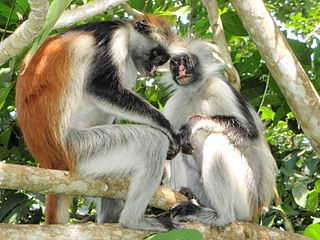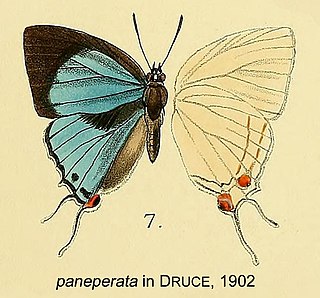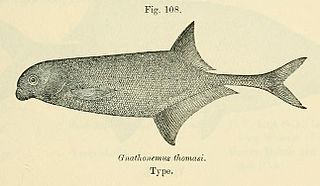
Mackerel is a common name applied to a number of different species of pelagic fish, mostly from the family Scombridae. They are found in both temperate and tropical seas, mostly living along the coast or offshore in the oceanic environment.

Herring are forage fish, mostly belonging to the family of Clupeidae.

The International Union for Conservation of Nature (IUCN) Red List of Threatened Species, also known as the IUCN Red List or Red Data Book, founded in 1964, is an inventory of the global conservation status and extinction risk of biological species. A series of Regional Red Lists are produced by countries and organizations, which assess the risk of extinction to species within a political management unit.

The macaques constitute a genus (Macaca) of gregarious Old World monkeys of the subfamily Cercopithecinae. The 23 species of macaques inhabit ranges throughout Asia, North Africa, and Europe. Macaques are principally frugivorous, although their diet also includes seeds, leaves, flowers, and tree bark. Some species such as the long-tailed macaque will supplement their diets with small amounts of meat from shellfish, insects, and small mammals. On average, a southern pig-tailed macaque in Malaysia eats about 70 large rats each year. All macaque social groups are arranged around dominant matriarchs.

Red colobuses are Old World monkeys of the genus Piliocolobus. It was formerly considered a subgenus within the genus Procolobus, which is now restricted to the olive colobus. They are closely related to the black-and-white colobus monkeys, and some species are often found in groups with the blue monkey. The western red colobus is frequently hunted by the common chimpanzee.

The African skimmer is a species of bird belonging to the skimmer genus Rynchops in the family Laridae. It is found along rivers, lakes and lagoons in Sub-Saharan Africa.
Livingston's bulldog Marcusenius livingstonii is a species of ray-finned fish in the family Mormyridae. It is found in Malawi, Mozambique, and Tanzania. Its natural habitats are rivers, intermittent rivers, and freshwater lakes. It is threatened by habitat loss.
Marcusenius sp. nov. 'Malindi' is a species of fish in the family Mormyridae. It is endemic to Kenya. Its natural habitat is rivers.
Marcusenius sp. nov. 'Turkwell' is a species of fish in the family Mormyridae. It is endemic to Kenya. Its natural habitat is rivers.
The Victoria stonebasher is a species of ray-finned fish in the family Mormyridae. It is found in Kenya, Rwanda, Tanzania, and Uganda. Its natural habitats are rivers, swamps, freshwater lakes, freshwater marshes, and inland deltas. It is threatened by habitat loss.

Atopochilus macrocephalus is a species of upside-down catfish endemic to Angola where it occurs in the Kwango River in the vicinity of Fort Don Carlos. This species grows to a length of 7.5 centimetres (3.0 in) SL. It is consumed for food and is threatened by human activities with very extensive diamond mining being the most significant threat.
Synodontis cuangoanus is a species of upside-down catfish that is native to Angola and the Democratic Republic of the Congo where it occurs in the Kwango River drainage. It was first described by Max Poll in 1971. The original specimens were obtained in Cuango, Cafunfo, in what is now the Democratic Republic of the Congo. The species name cuangoanus is derived from "Cuango", the location where the species was first discovered, and the suffix -anus, meaning "belonging to".

Iolaus paneperata, the parallel sapphire, is a butterfly in the family Lycaenidae. The species was first described by Hamilton Herbert Druce in 1890. It is found in Sierra Leone, Ivory Coast, Ghana, Togo, Nigeria, Cameroon, the Republic of the Congo and the Democratic Republic of the Congo.

Marcusenius thomasi is a species of ray-finned fish in the family Mormyridae. It is found in Guinea, Guinea-Bassau, Liberia, and Sierre Leone. Its natural habitats are rivers, intermittent rivers, and freshwater lakes. It is threatened by Mining and deforestation.

Endangered species, as classified by the International Union for Conservation of Nature (IUCN), are species which have been categorized as very likely to become extinct in their known native ranges in the near future. On the IUCN Red List, endangered is the second-most severe conservation status for wild populations in the IUCN's schema after critically endangered. In 2012, the IUCN Red List featured 3,079 animal and 2,655 plant species as endangered worldwide. The figures for 1998 were 1,102 and 1,197 respectively.

The Mormyroidea are a superfamily of fresh water fishes endemic to Africa that, together with the families Hiodontidae, Osteoglossidae, Pantodontidae and Notopteridae, represents one of the main groups of living Osteoglossiformes. They stand out for their use of weak electric fields, which they use to orient themselves, reproduce, feed, and communicate.

Marcusenius furcidens is a species of electric fish in the family Mormyridae, found in the Como, Bandama, Sassandra, Bia and Tano rivers. It is native to the Ivory Coast and Ghana; it can reach a size of approximately 286 mm (11.3 in).
Marcusenius abadii is a species of electric fish of the family Mormyridae found in the Niger, Benue and Volta rivers. It is native to Burkina Faso, Ghana, Niger and Togo; it can reach a size of approximately 400 mm.
Marcusenius brucii is a species of electric fish in the family Mormyridae found in the Ogun, Oshun and Mono rivers. It is native to Nigeria and Togo; it can reach a size of approximately 330 mm.












